

Mathematics Education Resources. Intermediate 2020 DSBN Scope & Sequence. Junior 2020 DSBN Scope & Sequence. Curriculum and Resources. Solar Panels 3 Act Math Activity. Calling Bullshit — Syllabus. Logistics Course: INFO 270 / BIOL 270.
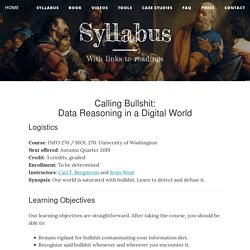
University of Washington Next offered: Autumn Quarter 2019 Credit: 3 credits, graded Enrollment: To be determined Instructors: Carl T. Bergstrom and Jevin West Synopsis: Our world is saturated with bullshit. Learn to detect and defuse it. An Introduction to Tree Diagrams. What is a Tree Diagram?
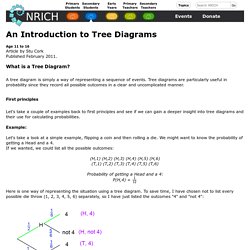
A tree diagram is simply a way of representing a sequence of events. Tree diagrams are particularly useful in probability since they record all possible outcomes in a clear and uncomplicated manner. First principles Let's take a couple of examples back to first principles and see if we can gain a deeper insight into tree diagrams and their use for calculating probabilities. Why Start with Tree Diagrams? This article is part of our collection Great Expectations: Probability through Problems.
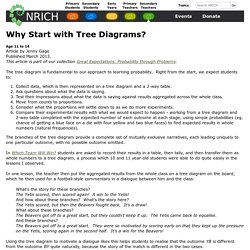
The tree diagram is fundamental to our approach to learning probability. Right from the start, we expect students to: Collect data, which is then represented on a tree diagram and a 2-way table.Ask questions about what the data is saying.Test their impressions about what the data is saying against results aggregated across the whole class.Move from counts to proportions.Consider what the proportions will settle down to as we do more experiments. Compare their experimental results with what we would expect to happen - working from a tree diagram and 2-way table completed with the expected number of each outcome at each stage, using simple probabilities (eg. chance of getting a blue face on a die with four yellow and two blue faces) to find expected results in whole numbers (natural frequencies).
In Which Team Will Win? John Venn's 180th Birthday. John Venn was a logician and philosopher best known for introducing the Venn diagram.
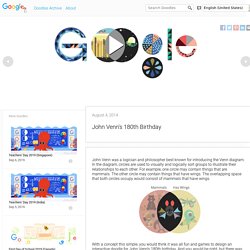
In the diagram, circles are used to visually and logically sort groups to illustrate their relationships to each other. For example, one circle may contain things that are mammals. The other circle may contain things that have wings. The overlapping space that both circles occupy would consist of mammals that have wings. With a concept this simple, you would think it was all fun and games to design an interactive doodle for John Venn’s 180th birthday. How did the idea develop? Carroll Diagrams. Graphing Stories - 15 seconds at a time.
Formative Assessment Lessons. Mathematical goals This unit is designed to help students to: Confront and overcome common probability misconceptions.Count equally likely outcomes using diagrams.Discuss relationships between theoretical probabilities, observed outcomes, and sample sizes.Calculate probabilities of independent events.
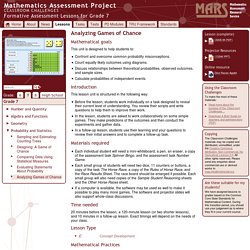
Introduction. First Steps Mathematics - Steps Resources. Data Management and Probability. Be sure to check out the Guide to Effective Instruction Data Management and Probability Grades 4 to 6 to help with planning and instruction.
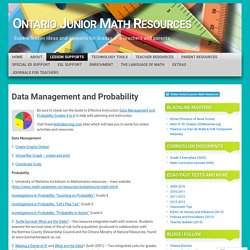
Visit these linktolearning.com sites which will take you to some fun online activities and resources. Data Management 1. Create Graphs Online! 2. Scratch.mit. ⭐ White-TD. Simple Monty Hall. Quanta Magazine. Our August Insights puzzle challenged you to make sense of the daily torrent of COVID-19 data as an exercise in personal risk management.

Our first puzzle required judging the reliability and proper application of the key statistics that we are all familiar with: confirmed cases, reported deaths and testing numbers. What makes this hard is that it requires reasoning in the face of uncertainty, and even sophisticated modeling groups don’t agree completely. Nevertheless, it’s a great exercise for clarifying one’s concepts. In general, there are several tested methods in science for making headway in these kinds of situations: 1. La dernière banane : une illustration des probabilités - Leonardo Barichello. What will you do in Math today? Solargraphy : 7 Steps - Instructables. Once you have your cameras loaded and light-tight, you need to figure out where you are going to place them.

Ideally, you want to have a clear view of the sun as it moves across the sky, but interesting effects can be made when cameras are placed behind other objects. You could point your can generally at the area where the sun sets, turning it slightly in the direction of where the sun just came from. There are a few things to consider before placing your cameras. - In today's world, people are easily alarmed by cylindrical objects taped to buildings, lampposts, etc. The Virtual Museum of Métis History and Culture. Dice Roller. Scratch.mit. Sets & Subsets. Back to the future – Math Knowledge Network.
The KNAER Math Knowledge Network presents Coding has a past: a long history with mathematics education.
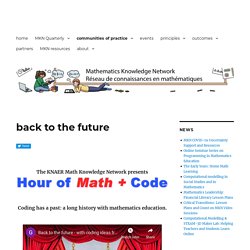
In partnership with Wellington Catholic District School Board, St. Brock Dubbels PongWorkshopWorksheet. ScratchEd. Scratch cards. Institute of Education - UCL – University College London. Professional development is a key component of the ScratchMaths curriculum as it encompasses not only the learning content but also a particular pedagogical approach, which we call the 5Es and is described briefly below.
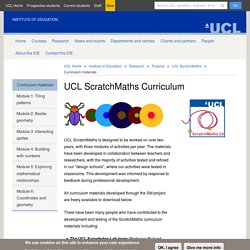
Ideally, all teachers will have the opportunity to participate in the ScratchMaths PD events organised by one of our partners who have been involved in the project for several years and are experienced in providing PD sessions that appropriately prepare teachers to deliver ScratchMaths within their classrooms. In you are interested in attending ScratchMaths PD please get in contact with your nearest ScratchMaths PD provider. Explore. Digital Technologies Hub. Vector Scratch Blocks. In September 2014 Computing will be a new curriculum subject and I wanted to make some resources that could be used to support Scratch After seeing these hands-on blocks I thought it would be great if anyone could make their own. So I set about creating some vector versions of the standard Scratch blocks that could be scaled to any size required.
As I created them I also thought how useful it would be if Teachers could use them in other ways, for example, displays, PowerPoints and on Interactive Whiteboards. CS Fundamentals Unplugged Lessons. Each of these activities can either be used alone or with other computer science lessons on related concepts. 2019-20 CS Fundamentals Curriculum 2019 Course A-F Curriculum Book Course A-F Supply List Course Amazon Lists Resources for older versions of CS Fundamentals.
Coding & Storytelling. Discerning Decomposition and computational disposition with Archelino: : A dialogue. Steven Khan & Sally Rudakoff This article is presented as a research informed dialogue between the two authors. It represents a reconstruction of conversations that occurred over several weeks, in person and via email as we explored the affordances of a wooden puzzle game for scaffolding understanding of the process of decomposition as used in computational thinking (CT) frameworks and computational dispositions in the early years alongside academic readings. We have not identified either one of us as S1 or S2. Splat! - Steve Wyborney's Blog: I'm on a Learning Mission. Welcome to Splat! You are only moments away from a VERY POWERFUL, highly interactive number sense strategy that can be used at any grade level! This post includes 50 (fifty!) Free, downloadable PowerPoint math lessons! Watch the video, download some (or all) of the lessons, and experience what happens when you unleash this resource in your classroom!
I’ve been excited to click the Publish button on this post for several weeks! Steve Wyborney's Blog: I'm on a Learning Mission. - Sharing Thoughts About Education. Clothesline Math – The Master Number Sense Maker. Clothesline – Expressions – Estimation 180. Day 207 – Estimation 180. Estimation 180 – Building Number Sense. The Ticket Roll - 101qs. 3-Act Task: A kindergarten lesson captured. Over the past few months I’ve been asked for videos that capture a 3-Act Task being taught in the elementary grades. I didn’t have any, or know of anyone that has captured an elementary 3-Act except for this Teaching Channel piece. Before moving forward, this post wouldn’t be possible without Dan’s trailblazing skills and introducing us all to 3-Act Tasks.
Last week while visiting a kindergarten class we tackled the Candyman. So in the spirit of vulnerability, here it is and I’ll take whatever feedback you can offer. Act 1: Notice and Wonder ***The blur will disappear after 30 seconds. Act 2: Identify Variables and Solve Conflict Here’s the kindergarten recording sheet our friends used to make estimates and show their thinking. After students estimated, we shared and identified the variables needed to answer the question, “How many candies were in Mr.
At this point students were good to go and got their model on. Here’s what we got… Mathforlove. Random Grouping Cards For Math Class – Mr. Orr is a Geek.com. Engaging Math: group sort cards. If you want a quick activity that you can use to randomly put students into groups of four, look no further. This activity uses fractions with common denominators and then equivalent fractions to sort students into groups. Teaching Through Problem Solving - NUMERACY in GPCSD. Celebrating 100 Years with Big Beautiful Problems (Grades 6–8) - Alicia Burdess and Jessie Shirley100 Days of Professional Learning, Online with the National Council of Teachers of MathematicsBig Beautiful Problems can be life-changing for teachers and students alike as they show how math becomes alive and is connected to our world.
Building Thinking Classrooms. How Single-Point Rubrics Can Improve The Quality Of Student Work. Online Resources. Online Resources. The Formative 5: Everyday Assessment Techniques for Every Math Classroom. Rich learning activities. Math Mistakes. Welcome to the Mathematics Assessment Project. Illustrative Mathematics. Illustrative Mathematics. Illustrative Mathematics. Illustrative Mathematics. Illustrative Mathematics. Illustrative Mathematics. Illustrative Mathematics. Illustrative Mathematics. Illustrative Mathematics. Make sure you have plenty of snap cubes. Build a rectangular prism that is 2 cubes on one side, 3 cubes on another, and 5 cubes on the third side.
We will say that the volume of one cube is 1 cubic unit. Dandy Candies - 101qs. Pumpkin Carving. Laser Challenge. Transformation Golf: Rigid Motion. Marbleslides: Lines. Connected & Creative Mathematics. Polygraph: Hexagons, Part 2. Turtle Crossing. Turtle Time Trials. Get Started — Learn Desmos. Why Do Students in Personalized Learning Programs Feel Less Positive About School? – EdTech Strategies. Rand Corporation just released the latest in its Bill & Melinda Gates Foundation-sponsored research series on personalized learning.
I’ve seem some good reporting on the study but also plenty of spinning of the findings by advocates (pro and con). In cases such as these, there is no substitute for actually doing the work and reading the study. While I may revisit the study (or series) in future posts, my purpose today is to share one counterintuitive finding (to me) reported in the study: Getting to Know Each Other. Desmos Middle School Math Program — Learn Desmos. Graphing Calculator. Scratch - Imagine, Program, Share. Area of a Trapezium. Area of Circles. Area of a Triangle. Parallelogram Area. Tessellation Creator. Math Snacks (Learning Games Lab) Geometry—Ancient Ropes and Modern Phones. The Man Who Saved Geometry.mp4. Zometool - The construction set treasured by kids and Nobel Prize winners. Kapla 1000 Piece Set in Wood Box with Wheels. LUX BLOX - Creative Building Toys. Products.
Free Math Apps - used by over 100 Million Students & Teachers Worldwide. Aperiodic Tessellations - EscherMath. Tessellations by Polygons - EscherMath. Quanta Magazine. Quanta Magazine. The Illuminating Geometry of Viruses. Quanta Magazine. Marjorie Rice’s Secret Pentagons. Sum of Angles of Triangle.